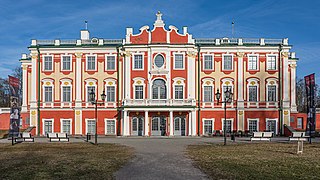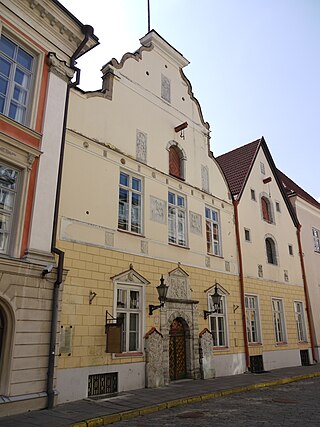
Tallinna Linnatranspordi AS (TLT) is a transportation company owned by the city of Tallinn, Estonia. TLT is a result of the merger of Tallinn Bus Company and Tallinn Tram and Trolleybus Company in July 2012. The company provides bus, trolleybus, and tram services in Tallinn.

Linnahall is a multi-purpose venue in Tallinn, Estonia. It is situated in the harbor, just beyond the walls of the Old Town, and was completed in 1980. The venue also features a heliport and a small seaport.

Estonia Theatre is an historic landmark building in central Tallinn, the capital city of Estonia. It houses the Estonian National Opera and the Estonian National Symphony Orchestra.
Eesti Ekspress is an Estonian weekly newspaper.

Tondi is a subdistrict in the district of Kristiine, Tallinn, the capital of Estonia. It has a population of 3,862.

Raekoja plats is a town square beside Tallinn Town Hall in the center of the Tallinn Old Town in Tallinn, Estonia.
The Art Museum of Estonia was established in 1919. Originally based in Kadriorg Palace, the museum has expanded across several sites and today exhibits both international and local art works. At the end of the 1970s, in the 1980s the first branches of the Art Museum of Estonia were founded. Starting in 1995, all of the branches offer different educational programmes for children and young people. In 1996, the exhibition hall on the first floor of Rotermann Salt Storage was opened; this branch was closed in May 2005.

Kadriorg is a subdistrict in the district of Kesklinn ("Midtown"), Tallinn, the capital of Estonia. It has a population of 4,561. The subdistrict name derives from the Catherinethal, a Baroque palace of Catherine I of Russia. It is one of the wealthiest neighbourhoods in Estonia.

Veerenni is a subdistrict in the district of Kesklinn (Midtown), Tallinn, the capital of Estonia. It has a population of 3,769.

Kadriorg Palace is an 18th-century Petrine Baroque palace in Kadriorg, Tallinn, the capital of Estonia. Both the Estonian and the German name for the palace means "Catherine's valley". It was built in 1718–1725 to Nicola Michetti's designs by Gaetano Chiaveri and Mikhail Zemtsov. The palace currently houses the Kadriorg Art Museum, a branch of the Art Museum of Estonia, displaying foreign art from the 16th to 20th centuries. The building of the Kumu branch of the museum, showing Estonian art from the 18th century onwards is located nearby in the Kadriorg Park.

Roosna-Alliku is a small borough in Paide municipality, Järva County in northern-central Estonia. Prior to the 2017 administrative reform in Estonia of local governments, it was the administrative centre of Roosna-Alliku Parish.
Ridaküla is a village in Kadrina Parish, Lääne-Viru County, in northern Estonia. It is located on the Tapa–Loobu road, about 5 km (3 mi) northeast of the town of Tapa. Ridaküla is bordered by the Tallinn–Tapa–Narva railway to the southeast and the Valgejõgi River to the southwest.

Fat Margaret is a tower in Tallinn, Estonia. Nowadays, the tower is home to Estonian Maritime Museum.

Kalev Sports Hall is a multi-purpose arena in Estonia. It was built in 1962 and holds up to 1,780 people (all-seater).

The Great Guild was a guild for merchants and artisans, operating in Tallinn from at least the 14th century until 1920. It was based in the Great Guild hall, a Gothic building in the historical centre of Tallinn, today housing the Estonian History Museum. In 2013, the Great Guild hall was named a European Heritage site.

Estonian Museum of Architecture is an architecture museum in Tallinn, Estonia. It is located in the Rotermann quarter. The museum is a member of ICAM.

House of the Blackheads, or House of the Brotherhood of Black Heads, in Tallinn, the capital of Estonia, is a former headquarters of the Brotherhood of Blackheads. Historically this was a professional association of ship owners, merchants and foreigners dating from the 14th century. They were active in Livonia but fled to Germany during the Soviet occupation of the Baltic States in 1940. The House of the Blackheads was visited by several Russian Emperors including Peter I, Paul I and Alexander I who also became honorable members the Brotherhood.

Solaris Center is a shopping and entertainment complex in Tallinn, Estonia. It is the largest entertainment, trade and cultural center in Tallinn. The center was projected by Raivo Puusepp. It was opened in March 2009. The net area of the center is 6,235 m2 (67,110 sq ft).

Tallinn Observatory is an observatory in Tallinn, Estonia. Since 1993, the observatory is a part of Tallinn University of Technology.

Lindamägi is a park in Tallinn, Estonia.


















